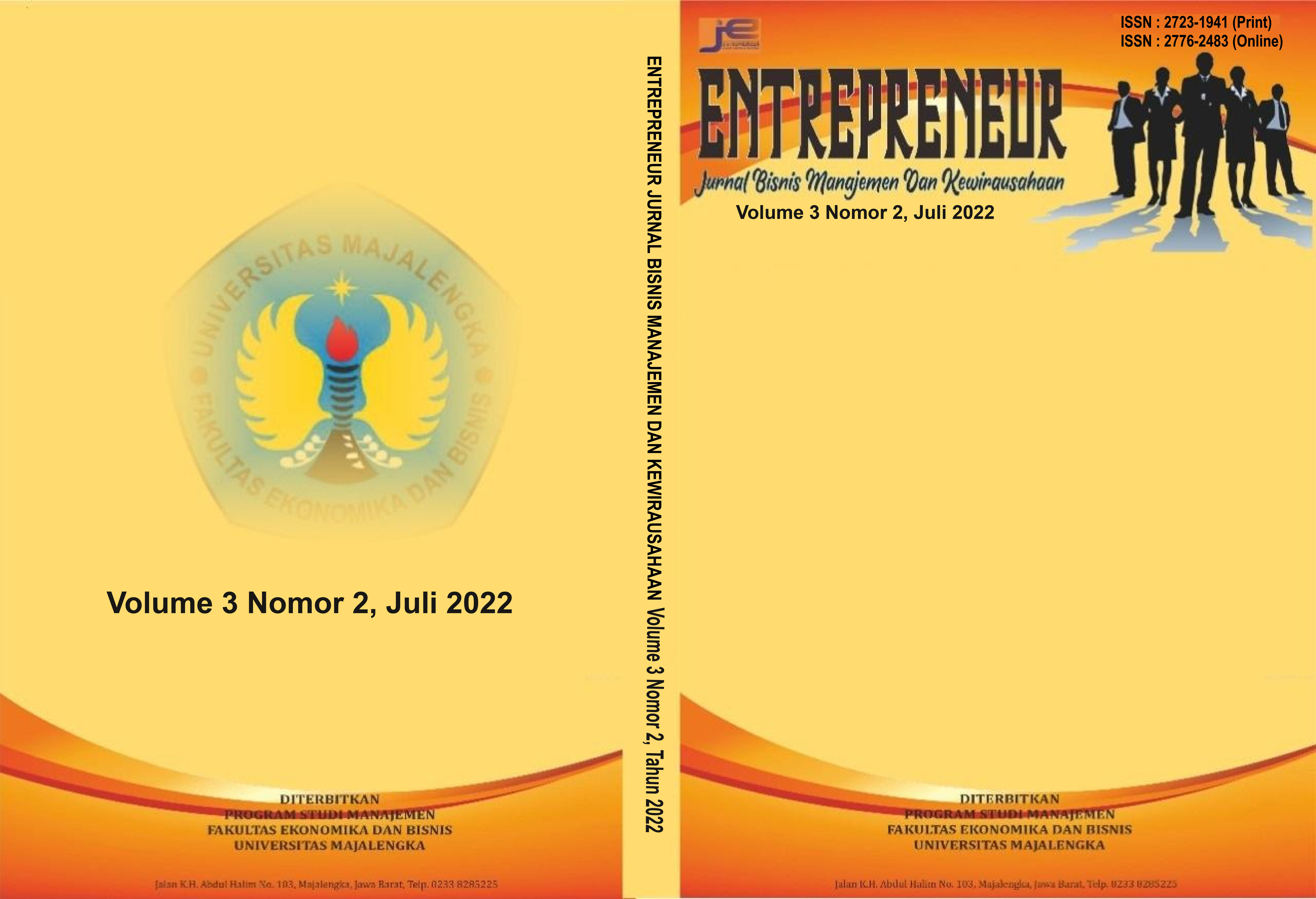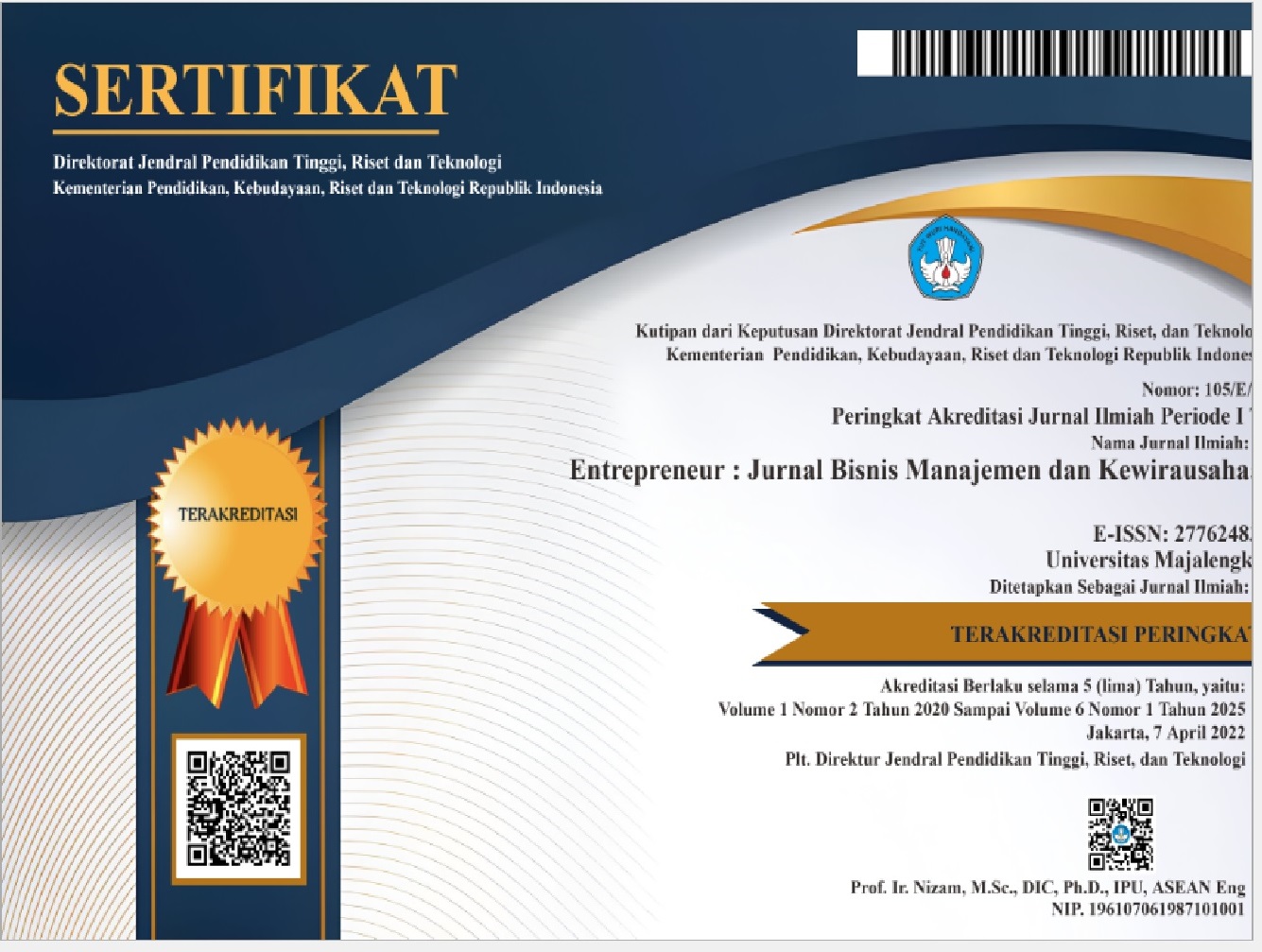ANALYSIS OF MARKETING STRATEGY IN DEALING WITH THE COVID-19 PANDEMIC
(Case Study In Gema Insani Publishing Company)
DOI:
https://doi.org/10.31949/entrepreneur.v3i2.1846Abstrak
The year 2020 was shaken by the spread of the Covid-19 virus. The viral pandemic occurred has changed the way of life of the world, at least from a social and economic perspective. Predictions of a recession began to emerge as the economy weakened due to the spread of the virus forcing large parts of the population to be laid off. Many businesses experience losses and even go out of business, or at least experience a decline in profits (Brewer, 2020). The economic impact of this disaster is likely to continue for several years to come. Gema Insani is a publishing company in Depok which has been directly affected by the pandemic. A proper marketing strategy is needed so that even if there is a decline in the level of product sales, the decline is still under control or does not cause the company to go out of business. This study aims to analyze the marketing strategies that the Gema Insani company implemented during the pandemic. The research was conducted using qualitative methods and descriptive analysis. It can be concluded from the research results that the applied marketing strategy includes the marketing mix of product aspects, price, place, promotion, people, process and physical evidence. The most dominant aspect in dealing with and adapting to pandemic situation is promotion aspect, that is by optimizing online marketing and product sales (digital marketing). By optimizing digital marketing, online product sales increased by 30%.
Kata Kunci:
Marketing Mix; Marketing Strategy; Pandemic COVID 19Unduhan
Referensi
Arikunto, Suharsimi. 2002. Metodologi Penelitian. Jakarta: PT. Rineka Cipta.
Belch, George E. & Belch, Michael A. 2007. Advertising and Promotion.
Bungin, Burhan. 2003. Analisis Data Penelitian Kualitatif Pemahaman Filosofis dan Metodologis Ke Arah Penguasaan Model Aplikasi. Jakarta: PT. Raja Grafindo Persada
David, F R. 2004. Manajenen Strategis. Edisi Kesepuluh. Buku I. Jakarta: Prenhallindo.
Faulkner, David dan Gerry Johnson. 1992. Strategi Manajemen. Jakarta: PT Elex Media Komputindo.
Finlay, L. 2006, “Going Exploring’: The Nature of Qualitative Research”, Qualit ative Research for Allied Health Professionals: Challenging Choices. Edi ted by Linda Finlay and Claire Ballinger. New York: John Wiley & Sons Ltd.
Goh dan Hor. 2003. Manajemen Strategi dan Aplikasi. Jakarta : Salemba Empat.
Guiltinan, J. and Paul. Strategi dan Program Manajemen Pemasaran. Edisi kedua. Jakarta: Erlangga.
Hadari, Nawawi. 2005. Metode Penelitian Bidang Sosial. Yogyakarta: Gadjah Mada University Press.
Kasiram, Moh., (2008), Metodologi Penelitian, Kuantitatif-Kualitatif, Malang: UIN Malang Perss
Kotler, P dan Keller, K. 2009. Manajemen Pemasaran (Terjemahan) Edisi 13. Jilid 1. Jakarta : PT Penerbit Erlangga
_________________. 2009. Manajemen Pemasaran (Terjemahan) Edisi 13. Jilid 2. Jakarta : PT Penerbit Erlangga
Kotler, P. 1997. Manajemen Pemasaran (Terjemahan). Jilid 1. Jakarta: Salemba Empat.
. and Armstrong G. 2001. Prinsip-Prinsip Pemasaran. Edisi Kedelapan. Jakarta: Erlangga.
. 1996. Struktur Pemasaran. Jakarta: Gramedia Pustaka Utama.
Moleong, Lexy J. 2007. Metodologi Penelitian Kualitatif, Bandung: PT Remaja Rosdakarya Offset
Nasir, Mohammad. 1998. Metode Penelitian, Ghalia Indonesia, Jakarta.
Porter, M.E. 1979. How competitive forces shape strategy. Harvard Business Review. March/April 1979.
Solomon, Michael. L., Elnora W. Stuart, 2003, Marketing, 3th Edition, Pearson Education, Prentice Hall.
Sugiyono. 2005. Memahami Penelitian Kualitatif. Bandung: ALFABET.
Sugiyono, (2012). Metode Penelitian Kuantitatif Kualitatif dan R&D. Bandung Alfabeta.

Diterbitkan
Cara Mengutip
Terbitan
Bagian
Lisensi
Hak Cipta (c) 2022 Anita Rahmawati,

Artikel ini berlisensiCreative Commons Attribution-ShareAlike 4.0 International License.
COPYRIGHT NOTICE
An author who publishes in the Entrepreneur: Jurnal Bisnis Manajemen dan Kewirausahaan agrees to the following terms:
1. Author retains the copyright and grants the journal the right of first publication of the work simultaneously licensed under the Creative Commons Attribution-ShareAlike 4.0 License that allows others to share the work with an acknowledgment of the work's authorship and initial publication in this journal
2. The author is able to enter into separate, additional contractual arrangements for the non-exclusive distribution of the journal's published version of the work (e.g., post it to an institutional repository or publish it in a book) with the acknowledgment of its initial publication in this journal.
3. The author is permitted and encouraged to post his/her work online (e.g., in institutional repositories or on their website) prior to and during the submission process, as it can lead to productive exchanges, as well as earlier and greater citation of the published work







